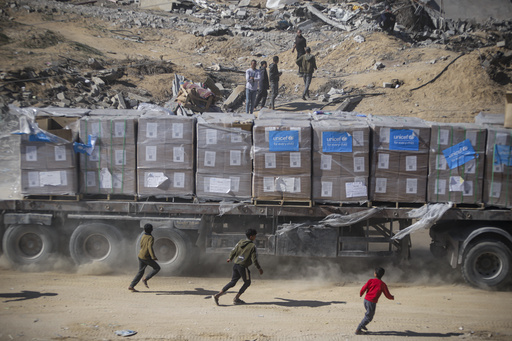JERUSALEM — Following a ceasefire between Hamas and Israel that began two weeks ago, significant amounts of aid are now flowing into the Gaza Strip. This support is crucial for a population grappling with severe hunger, widespread displacement, and destruction resulting from 15 months of conflict.
Despite this influx of assistance, local residents and humanitarian workers emphasize that challenges remain in ensuring aid reaches all those in need. The threat of renewed fighting continues to cast a shadow over the situation, especially with the looming end of the initial six-week ceasefire phase.
Under the terms of the ceasefire, Israel committed to permitting 600 aid trucks to enter Gaza daily— a substantial increase compared to previous levels. Reports indicate that approximately 4,200 trucks have been delivered each week since the ceasefire commenced.
However, aid distribution is hindered by various factors, including damage to transportation routes, inspections by Israeli authorities, and the danger posed by unexploded ordnance. In Jabaliya, a northern Gaza area devastated by Israeli offensives, Samir Abu Holi, 68, supervised a food distribution site. “I have more than 10 children, all of whom need milk and food. Before the ceasefire, we struggled for food access. Today, there is a glimmer of relief,” he stated.
The assistance surge has primarily involved the World Food Program, which announced that it delivered more food in the first four days of the ceasefire than in any month during the conflict. Over 32,000 metric tons of aid have now entered Gaza since the ceasefire began, with supplies being funneled through two northern and one southern crossing. Aid agencies have initiated the reopening of bakeries and the distribution of energy-rich biscuits, while Hamas police have returned to assist with maintaining order.
Prior to the ceasefire, non-governmental organizations faced numerous hurdles, including armed gangs looting aid shipments, violence against workers, stringent Israeli inspections, and difficulties in coordination with COGAT, the Israeli military unit overseeing aid efforts. Israeli officials have criticized the U.N. and humanitarian organizations for inadequately distributing aid once it arrived in Gaza.
Currently, the situation appears to be improving due to a newfound “political will,” as noted by Tania Hary of the Israeli organization Gisha. “COGAT is accelerating responses to coordination requests. Two crossings are now open in the north instead of just one. The ceasefire has allowed Hamas to oversee operations and reduce looting, significantly aiding the flow of assistance,” she explained.
However, despite the increased aid, the high cost of goods in local markets continues to pose a problem. Residents like Nadine Jomaa from Bureij have reported that while some prices are decreasing, essential items such as flour and cooking gas remain three times more expensive than before the conflict. “We survive on inexpensive canned food, but we need more basic supplies like water, kitchen items, and necessities for women,” she expressed.
While aid workers assert that an abundance of assistance could help mitigate extortion, many residents, particularly in northern Gaza, believe that the current aid influx has primarily enriched intermediaries. Complaints have arisen regarding the scarcity of essential resources like tents, while luxuries such as chocolate and soda have become surprisingly prevalent. Ahmed Qamar, who returned to the rubble of his previous home in Jabaliya, remarked, “Hundreds of families here are without shelter, yet the markets are filled with sweets and cigarettes.”
The delivery of specific types of aid remains restricted due to Israeli regulations regarding items deemed dual-use, which raises concerns about their potential repurposing for military activities. Some medical facilities and water treatment plants are still experiencing fuel shortages, with Hamas alleging that Israeli authorities have been obstructing the entry of medical supplies and construction equipment.
A recent communication from COGAT delineated items that require pre-approval for entry into Gaza, including desalination equipment and shelter construction tools. Items like large tents and portable toilets have been allowed in without prior approval. COGAT maintains that they have permitted numerous tents into Gaza without restriction in recent weeks while also extending crossing hours and facilitating road repairs.
The region’s infrastructure is heavily compromised, with many roads damaged and unexploded ordnance creating hazards. Estimates suggest that between 5% and 10% of all munitions deployed in Gaza have failed to detonate, posing ongoing dangers for both citizens and aid teams. The U.N. agency responsible for managing unexploded ordnance has reported that supply routes and areas populated with civilians continue to reveal various types of unexploded explosives.
As families return to what remains of their homes, many do so to find their water networks in ruins, leading to risks of dehydration and widespread disease due to subpar sanitary conditions. Jonathan Crickx, a UNICEF communications official, recounted witnessing families walking home with little more than the clothes on their backs, highlighting the dire circumstances they face.




